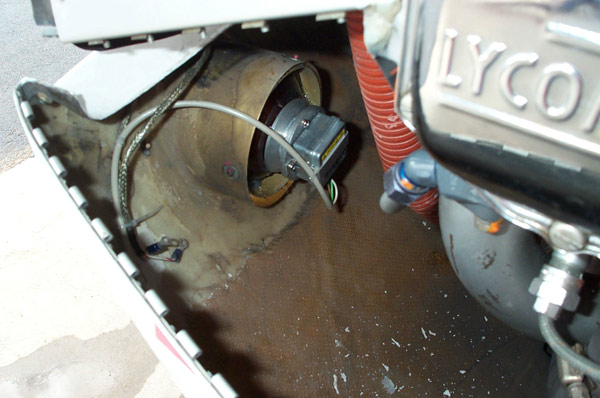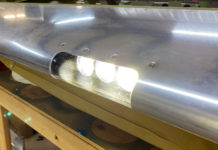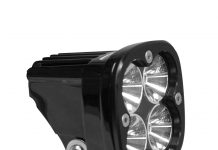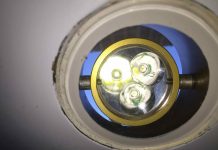Written by Dan Blumel – “XeVision” Reliable Sales
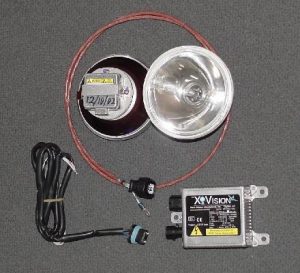 HID Xenon (metal halide) lamps utilize an electrical arc rather than a filament to generate a much brighter quantity of visible light. Normal vibration and filament thinning due to use, occurring in traditional incandescent lamps, play no role in the expected life for HID lamps. HID’s typically have a life in excess of 3,000 hours or over 20,000 on/off cycles, and over 5,000 hour life is not at all uncommon especially where longer duration usage occurs. Note: Pulsing of HID lights is strongly advised against due primarily to the 20,000 on/off cycle design capability (just do the math, 15-20 operating hours of pulsing use is what can be expected), it is also hard on the electronics as well and generates substantially more noise (EMI/RFI) than normal operation.
HID Xenon (metal halide) lamps utilize an electrical arc rather than a filament to generate a much brighter quantity of visible light. Normal vibration and filament thinning due to use, occurring in traditional incandescent lamps, play no role in the expected life for HID lamps. HID’s typically have a life in excess of 3,000 hours or over 20,000 on/off cycles, and over 5,000 hour life is not at all uncommon especially where longer duration usage occurs. Note: Pulsing of HID lights is strongly advised against due primarily to the 20,000 on/off cycle design capability (just do the math, 15-20 operating hours of pulsing use is what can be expected), it is also hard on the electronics as well and generates substantially more noise (EMI/RFI) than normal operation.
We are working on a solution to this pulsing limitation and should have a resolution out of final testing and ready for production in about 6 months. This feature will be an option.
The light output of these HID lights is much stronger (500,000 Candle Power) than traditional incandescent lamps, even with significantly less power required, about 5X the candle power of a standard 4509 100 watt incandescent. (See Photo #1) The lights put out much less than 1/2 the radiated heat of a 100 watt incandescent primarily because there is very little output above 700 nm (infrared). The electrical load is also less than 1/2 of either 4509 or 4509Q, which draw 7-8 amps in a 12/14 volt system. Our system will draw 3 to 3.5 amps nominally, (1.5 to 2 amp draw using a 24/28 volt system). Our power supply’s (ballasts) are over/under voltage and polarity protected. Our lights are extremely efficient at producing light instead of heat, 94 lumens/watt versus about 17 or 18 lumens of light per watt for an incandescent lamp.
 The arc gap between the tungsten electrodes is approximately 4mm in length. The resulting light source produced is about the same size as the arc gap. The majority of the light spectrum (wavelengths) generated falls between about 350 nm (nanometers) and 700 nm. The second glass (cerium doped quartz) envelope over the arc tube is for filtration of harmful ultraviolet between 250 and 315 nm UVB/C (UVB & C are the most harmful) and a very small amount of UVA (least harmful) passes the filter. The overall color temperature of the light produced is 4,200 Kelvin, which is very close to natural daylight. The technology used to generate this type of light is very similar to that used in large stadium lighting and has a very similar color temp. output. Note: The very blue or purple headlights you see on the road recently are either blue/purple tinted glass incandescent halogen bulbs or in some case HIDs with 6,000 to 8,000 Kelvin bulbs. These more blue/purple colored outputs are “designer colors” and are only cosmetic in purpose (they are “way cool looking”). They put out less total and/or useful light. The aviation white output bulbs are the only ones suitable for “our” application and the only ones we will offer.
The arc gap between the tungsten electrodes is approximately 4mm in length. The resulting light source produced is about the same size as the arc gap. The majority of the light spectrum (wavelengths) generated falls between about 350 nm (nanometers) and 700 nm. The second glass (cerium doped quartz) envelope over the arc tube is for filtration of harmful ultraviolet between 250 and 315 nm UVB/C (UVB & C are the most harmful) and a very small amount of UVA (least harmful) passes the filter. The overall color temperature of the light produced is 4,200 Kelvin, which is very close to natural daylight. The technology used to generate this type of light is very similar to that used in large stadium lighting and has a very similar color temp. output. Note: The very blue or purple headlights you see on the road recently are either blue/purple tinted glass incandescent halogen bulbs or in some case HIDs with 6,000 to 8,000 Kelvin bulbs. These more blue/purple colored outputs are “designer colors” and are only cosmetic in purpose (they are “way cool looking”). They put out less total and/or useful light. The aviation white output bulbs are the only ones suitable for “our” application and the only ones we will offer.
The arc tube has xenon gas in it (for instant on performance at about 3 atmospheres when cold and 4 to 6 atmospheres when hot). There is also mercury in the bulb, and when it is vaporized the mercury adds at least 20 atmospheres of pressure for a total pressure of around 30 atmospheres. Metal halides (salts) are also in the arc tube. The formulation in aviation HID lamps includes sodium and scandium halides (probably iodides) with traces of others such as lithium and thallium halides.
The power supply (ballast) is actually a “smart inverter” Converting DC voltage to 400 hz (square wave) AC. The output from the igniter to initiate the spark is 23 kilovolts maximum. This voltage depends upon age of the bulb (arc gap gets larger with age) and bulb temperature which affects the voltage required. Higher voltages are required for a “re-strike” when the bulb is hot. The power supply constantly optimizes the voltage and current necessary to sustain the arc and provide continuous bright operation. Stabilized D1S input voltage is 85+17 volts AC.
Third generation (D1S or D1R bulbs) include the igniter integral with the bulb. (see Photo #3) The igniter boosts the starting feed voltage (1,000 Volts AC) from the power supply to initiate the arc 20+ KV AC and start the bulb. Once the arc is initiated the voltage through the lamp feed cable very rapidly drops down to 85+17 VAC. The first generation is the oldest, least expensive and still the most common HID technology being sold today. First generation ballasts contain both the igniter and power supply in the same housing and utilize D2S or D2R bulbs. Note: D1R and D2R bulbs are not suitable for any aviation applications because they place a restriction in the beam pattern to create a non symmetrical in 3 dimensions, beam pattern. The first generation approach greatly limits the cable length between the bulb and ballast to 12-18 inches and cannot be lengthened because of increased voltage drop through a longer cable during high voltage start-up. Also installation location flexibility for the ballast is greatly restricted. This High Tension (high voltage 20+KV) cable is quite thick and very inflexible in comparison to the third generation (D1S) systems. D1S systems can have cable length in excess of 10 feet. Another downfall of the first generation systems is the very much higher voltage through the bulb feed cable and the resulting substantial increase in EMI (Electro Magnetic Interference) and RFI (Radio Frequency Interference). Both of these types of “noise” can be problematic for aviation and should be avoided as much as practical.
The second generation is a “transition” system between first and third generation. The igniter “box” is placed in the cabling between the power supply and bulb. This provides more flexibility in cable length but does not deal with the EMI/RFI issues when the igniter is not integral with the bulb as in D1S. The second generation systems are also more commonly sold today than the third generation (D1S) but still less common than first generation. The same D2S/D2R bulbs are used in both first and second generation systems.
The Par-36 or Par-46 commonly used designation for round aviation incandescent lamps correlates to reflector diameter. The 36/46 sizes are based on 1/8 inch increments. Therefore the nominal diameter of a Par-36 reflector housing is 36 eights of an inch or 4.5 inches and is a direct replacement for the 4509 incandescent used in all Glasair kits. (see photo 4) The diameter is actually closer to 4.35 inches. A Par-46 reflector housing is 46 eighths of an inch diameter which correlates to 5.75 inches diameter. The actual diameter in this case is about 5.7 inches.
Some may be offering a “50 watt” system. 50-watt HID Xenon bulbs DO NOT exist anywhere for sale as of this writing. 50-watt ballasts do exist but are quite rare and are not generally on the market either (we could offer 50 watt ballasts but will not until our 50 watt bulb is ready). Some other suppliers are using standard 35 watt bulbs with a 50 watt ballast (a shortsighted mistake) they overdrive the 35 watt bulb, greatly increasing the likelihood of bulb explosion (overdriving is not covered under warranty). Overdriving cuts the life in half and the light output (brightness) drops off early and significantly with use over this shortened life. This is not the “right” way to do it and not the way we are doing it (like getting a wine to market before its “ready”). We are doing prototype performance testing on a real 50 watt bulb/ballast system as we speak. The output of our 50 watt bulb is 75% greater than the 35 watt model (5,700+ lumens compared to 3,300 lumens for the 35 watt and our light output is sustained) The 50 watt system will be even more efficient, at 114 lumens per watt compared to 94 lumens for the 35 watt system. We should have this product ready within about 6 months also. It will be a 50 watt bulb and a 50 watt ballast both designed for 50 watt operation, with a full warranty. The power consumption will be less than 60 watts total or 4 to 5 amps at 12/14 Volts and 2 to 2.5 amps at 24/28 Volts.
We are doing a great deal of testing and development, thus our recently upgraded 35,000 foot operation limit. Most other products are warrantied to only 12,000 ft., if warrantied at all (automotive products, due to the fact that the highest roads in the world are about this altitude). We now offer optional custom length double-shielded (foil & braid) ballast to bulb cables to over 10 feet in length. This provides the best EMI/RFI performance and installation flexibility and includes teflon/tefzel wire (aircraft grade).
In closing, this technology is very well suited to meet many of the lighting needs throughout aviation. We are doing our best as we continue to mature the technology, providing products to meet the needs as they exist now throughout the aviation industry and developing suitable new applications into the future. We are also in the process of developing a retractable model.
For more information visit www.xevision.com.


